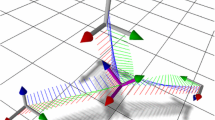Abstract
This paper constructs metrics on the space of images I defined as orbits under group actions G. The groups studied include the finite dimensional matrix groups and their products, as well as the infinite dimensional diffeomorphisms examined in Trouvé (1999, Quaterly of Applied Math.) and Dupuis et al. (1998). Quaterly of Applied Math. Left-invariant metrics are defined on the product G × I thus allowing the generation of transformations of the background geometry as well as the image values. Examples of the application of such metrics are presented for rigid object matching with and without signature variation, curves and volume matching, and structural generation in which image values are changed supporting notions such as tissue creation in carrying one image to another.
Similar content being viewed by others
References
Bajcsy, R. and Kovacic, S. 1989. Multiresolution elastic matching. Computer Vision, Graphics, and Image Processing, 46:1-21.
Bajcsy, R., L ieberson, R., and Reivich, M. 1983. A computerized system for the elastic matching of deformed radiographic images to idealized atlas images. Journal of Computer Assisted Tomography, 7(4):618-625.
Bakircioglu, Muge, Grenander, Ulf, Khaneja, Navin, and Miller, Michael. 1998. Curve matching on brain surfaces using frenet distances. Human Brain Mapping, 6(5):329-332.
Do Carmo, M.P. 1992. Riemannian Geometry. Birkaüser.
Christensen, G.E. 1999. Consistent linear-elastic transformations for image matching. In XVIth International Conference on Information Processing in Medical Imaging,A. Kuba and M. Samal
Dann, R., Hoford, J., Kovacic, S., Reivich, M., and Bajcsy, R. 1989.Evaluation of elastic matching systems for anatomic (CT, MR) and functional (PET) cerebral images. Journal of Computer Assisted Tomography, 13(4):603-611.
Davatzikos, C. 1997. Spatial transformation and registration of brain images using elastically deformable models. Comp. Vision and Image Understanding, 66(2):207-222.
Dengler, J. and Schmidt, M. 1988. The dynamic pyramid-a model for motion analysis with controlled continuity. International Journal of Pattern Recognition and Artificial Intelligence, 2(2): 275-286
Dupuis, P., Grenander, U., and Miller, M. 1998. A Variational Formulation of a Problem in Image Matching. Quarterly of Applied Math. 56, pp. 587-600.
Gee, J., Briquer, L.L., Haynor, D.R., and Bajcsy, R. 1994. Matching structural images of the human brain using statistical and geometrical image features. In Visualization in Biomedical Computing, volume SPIE 2359, pp. 191-204.
Grenander U. 1993. General Pattern Theory. Oxford Science Publications.
Grenander, U. and Keenan, D.M. 1991. On the shape of plane images. Siam J. Appl. Math., 53(4):1072-1094.
Grenander, U. and Miller, M.I. 1994. Representations and knowledge in complex systems. J. Roy. Stat. Soc, 56(3): 549-603.
Grenander, U., Miller, M., and Srivastava, A. 1998. Hilbert-Schmidt, Lower Bounds for Estimators on Matri Lie Groups for ATR, IEEE PAR I20(8).
Hagedoorn, M. and Veltkamp, C.1999. R. Reliable and efficient pattern matching using an affine invariant metric. International Journal of Computer Vision, 31:203-225.
Joshi, S. 1997. Large deformation diffeomorphisms and Gaussian random fields for statistical characterization of brain sub manifolds. PhD Thesis, Dept. of Electrical Engineering, Sever Institute of Technology, Washington Univ., St. Louis, MO, Aug.
Miller, M.I., Christensen, G.E., Amit, Y., and Grenander, U. 1993. Mathematical textbook of deformable neuroanatomies. Proceedings of the National Academy of Science, 90(24).
Pennec, X. and Ayache, N. 1998. Uniform distribution, distance and expectation problems for geometric features processing. Journal of Mathematical Imaging and Vision, 9(1):49-67.
Rabbitt, R.D., Weiss, J.A., Christensen, G.E., and Miller, M.I. 1995. Mapping of hyperelastic deformable templates using the finite element method. Presented at the International Symposium on Optical Science, Engineering and Instrumentation, July.
Trouvé, A. 1999. Infinite dimensional group action and pattern recognition Unpublished preprint (Ecole Normale Superioure).
Younes. L. 1998. Computable elastic distances between shapes. SIAM J. Appl. Math, 58(2):565-586.
Younes, L. 1999. Optimal matching between shapes via elastic deformations. Image and Vision Computing Journal, to appear.
Author information
Authors and Affiliations
Rights and permissions
About this article
Cite this article
Miller, M., Younes, L. Group Actions, Homeomorphisms, and Matching: A General Framework. International Journal of Computer Vision 41, 61–84 (2001). https://doi.org/10.1023/A:1011161132514
Issue Date:
DOI: https://doi.org/10.1023/A:1011161132514




